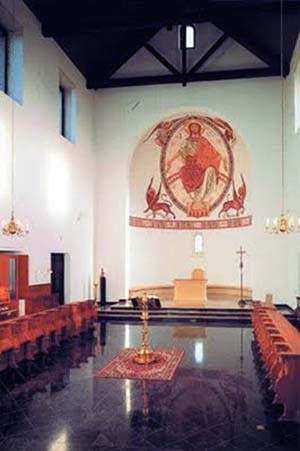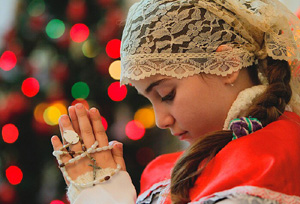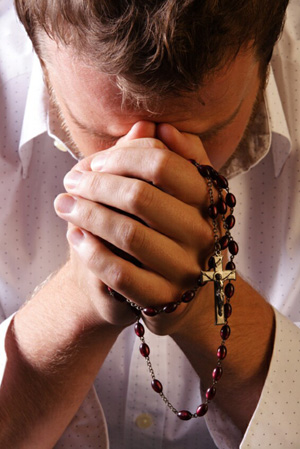The Dialogue Mass, a Tool
to Democratize Liturgy
Dr. Carol Byrne, Great Britain
The year 1909 marks the decisive moment when the worm of decay entered the liturgical scene and slowly began to devour the traditional rites from the inside. This was the year in which Dom Lambert Beauduin presented his ideas for more “active” lay participation in the liturgy at the National Congress of Catholic Action in Malines on the invitation of Cardinal Désiré Joseph Mercier.
His address was entitled ‘The True Prayer of the Church’ (La Vraie Prière de l’Église), and was published as part of Beauduin's book The Piety of the Church (La Piété de l’Église) in 1914. (1) In it, he proposed a “pastoral” plan for what he claimed were Pope Pius X’s directives for “active participation.”
He mentioned in his lecture, among other things, his plan to familiarize the laity with the text of the Mass and Divine Office through the widespread use of bi-lingual hand-missals.
The idea behind the proposal was, so he averred, to fulfill Pope Pius X’s aim to help lay people achieve a greater degree of participation in the liturgy as the “primary and indispensable source of the Christian spirit.”
All shall have Missals
But there was a great deal more behind the innocuous-sounding strategy. Already a major revolution had been gathering momentum in his mind and the 1909 Congress in Malines was only the first platform for views he had been elaborating for some time.
At the top of his agenda at the Congress was a proposal to publish and disseminate thousands of missals with vernacular translations, not in order for the faithful to read silently as an option, but so as to make the Dialogue Mass the norm for all. “Let us change the routine and monotonous assistance at acts of worship into an active and intelligent participation; let us teach the faithful to pray and confess these truths in a body,” Beauduin announced. (2)
 The Chapel today at Chevertogne Abbey founded by Beauduin in 1925
The Chapel today at Chevertogne Abbey founded by Beauduin in 1925[color][size][font]
This strategy was based on nothing other than his own highly subjective notions of lay participation. It indicated a fatuous optimism about fostering a “community spirit” by having every member of the congregation barking like trained seals, with the priest as the ringmaster.
He even admitted to wanting to deprive Catholics of their traditional method of participation by eliminating all forms of private prayers, which they recited silently during the Mass. (3) These would include the Rosary, devotional exercises or even meditations.
In other words, Beauduin wanted collective verbal responses to be the medium of lay participation. Strictly “liturgical prayer” would be d
e rigueur for the faithful. (4) But his plan did not stop there. In his programme of action formulated at the Malines Congress, he expressed the wish that even outside the liturgy the faithful should give up their devotional exercises and model their prayers on the priest’s Breviary: e.g. Compline should take the place of private evening prayers.
It was basically an assault on their freedom to pray as individuals in their own way – a freedom later vindicated by Pope Pius XII in 1947 (
Mediator Dei § 108). The same Pope censured those “who are deceived under the pretext of restoring the liturgy or who idly claim that only liturgical rites are of any real value and dignity” (
ibid. §176), and he also rejected as “wrong and dangerous” any attempt on the part of the reformers to reduce exercises of popular piety to the methods and norms of liturgical rites (
ibid. § 184).
Silent participation forbidden[/font][/size][/color]
 A burning desire to do away with quiet prayer and private devotions
A burning desire to do away with quiet prayer and private devotions

[color][size][font]
It is important not to underestimate the seriousness of the proposal to make the Dialogue Mass the outcome of participation for all the faithful. A centuries-old custom of silent prayer that flowed from the faith and practice of generations of Catholics was about to be abolished, sacrificed on the altar of a destructive egalitarianism in which everyone’s “active participation” – whether clerical or lay – is treated as of equal status.
It was also a totalitarian measure in which the individual is sacrificed to the collective. The faithful, exhorted to join in the collective vocal responses, would no longer be free to choose whichever method of silent participation works best for them. Experience shows that, for those wishing to join their minds and hearts to the Holy Sacrifice being re-enacted on the altar, interior recollection can be distracted by the intrusive voices of others in the pews.
Henceforth, wherever the Dialogue Mass took root, the atmosphere of Catholic worship in the Roman rite would be forever changed as spoken responses drowned silent participation. What is more, silent participation has become a sort of lightning rod for the hatred of liturgical reformers. Indeed, it is now held to be an affront to democratic values in the “age of the laity” inaugurated by Vatican II.
This explains why
Novus Ordo priests have been known to react with a mixture of horror and outrage at the sight of any Catholic in the pews fingering a Rosary or reading from a prayer book in the traditional style, and why they expose them to the general derision of the congregation.
The tip of an iceberg Proponents of the Dialogue Mass and congregational singing contend that these forms of “active participation” were what Pope Pius X intended in his 1903
motu proprio. But that is simply an unwarranted assumption, which sprang from the fevered brain of Dom Lambert Beauduin, who wanted to start a liturgical revolution to “democratize” the liturgy. (5)
Significantly, there was no popular demand from the laity for “active participation” or desire on their part to be invested with clerical roles. The Dialogue Mass, which aids such an inversion of roles, was just the visible tip of an iceberg of “active participation,” the enormity of which was hidden under the waves in Pope Pius X’s time.
As the following articles will show, the landmark date of 1909 when Beauduin launched the Liturgical Movement stands as a monument to the state of degeneracy into which the liturgy fell after Vatican II.
Continued [/font][/size][/color]
- Beauduin, La Piété de l’Église : principes et faits, Louvain: Monastery of Mont César, 1914, published in English translation by Virgil Michel as Liturgy the Life of the Church, Collegeville, Minnesota, 1926
- Lambert Beauduin, Liturgy the Life of the Church, translation by Virgil Michel, Collegeville, Minnesota: The Liturgical Press, 1914, p. 11
- “Thus, all the faithful will be led to renounce their private prayers during the sacred ceremonies - Mass and Divine Office” (Ainsi tous les fidèles seront amenés à renoncer pendant les offices divins à la récitation de prières privées). Lambert Beauduin, "La Vraie Piété de l’Eglise, Rapport au Congrès de Malines 1909," in Questions Liturgiques et Paroissiales, 40, 1959, p. 221, apud Marc Chatanay, Emergeance du Mouvement Liturgique en France, Pamplona, 2009, p. 215.
- Incidentally, the founder of Opus Dei, Mgr. Josemaría Escrivá, had the same aim. In The Way (a book of maxims addressed to Catholics, Schismatics and Protestants), Mgr. Escrivá stated: “Your prayer should be liturgical. How I would like to see you using the psalms and prayers from the missal, rather than private prayers of your own choice” (n. 86) .
- Keith Pecklers, The Unread Vision: Liturgical Movement in the United States of America, 1926-55, Liturgical Press, Collegeville, Minnesota, 1998, p. 11.